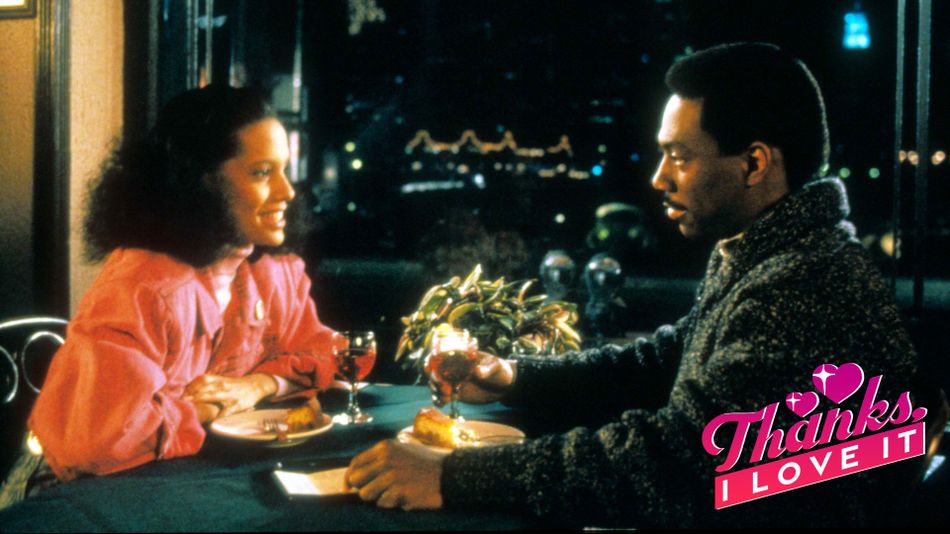
Image: Moviestore / Shutterstock / Mashable Composite
If you asked me to pick out my one most vividly remembered scene from Coming to America, the classic Eddie Murphy comedy released in 1988, it would be the Trading Places moment.
Murphy’s Prince Akeem of Zamunda is out on a date with his future wife Lisa McDowell (Shari Headley). But he’s got a problem: Lisa doesn’t know about Akeem’s immense wealth and royal lineage, and Akeem, who is trying to pass himself off as a goat herder, ends up stuck with a paper bag filled with thousands of dollars thanks to his meddling friend and personal servant, Semmi (Arsenio Hall).
Enter the two homeless men sitting right outside the restaurant where Akeem and Lisa will have their date. Akeem pauses before they go inside and slips the men his paper bag. A few minutes later, after the happy couple is seated at their table, the homeless men reappear to shout thanks through a nearby window and we in the audience are hit with a realization: It’s Randolph (Ralph Bellamy) and Mortimer Duke (Don Ameche), the chief antagonists in the Murphy comedy classic Trading Places.

Image: Paramount / Kobal / Shutterstock
I unabashedly adored Coming 2 America, the long-awaited sequel that recently arrived on Amazon Prime Video, for many reasons. But the moment that stands out the most is once again a callback to Trading Places. When Akeem’s “bastard” son Lavelle (Jermaine Fowler) shows up for a job interview with a man played by Colin Jost, we learn that he’s “Mr. Duke,” grandson and nephew to the Dukes of yore.
When I step back and interrogate my appreciation for these two scenes, I see a few things going on. For starters, Coming to America is one of the things that awakened my brain to the idea of shared universe storytelling. I probably wouldn’t have put it quite that way in 1988, but my still-developing geek brain immediately picked up on something resonant in the original scene’s hint of a larger fictional world.
More than 30 years later, the sequel’s Jost cameo moment touches the exact same fandom nerve. Only it hits differently now. Thanks largely to Disney (by way of Marvel and Star Wars), I’m well-accustomed now to the richer storytelling that can surface when a work of entertainment nods consciously to fans. And building a generational bridge between the Dukes is exactly it.
Unserious though it may be, Coming 2 America succeeds because it immerses itself in the crass-but-fundamentally-wholesome ridiculousness that made the original movie such a legendary work. The humor tilts more toward dad jokes than outright raunch — a fitting evolution given Murphy’s real-life journey since 1988 — but all of it is guided by the same tone and sense of purpose.
It’s not that I’m now expecting a Trading Places sequel, or some deeper lean into building out a comedic cinematic universe to rival Marvel’s. (Wouldn’t that be grand, though?) The payoff has happened already. Without any prodding or fanfare, Coming 2 America paid respect to those fans who have hung on for all this time.

A glimpse at how the Duke brothers live on in “Coming 2 America.”
Image: screenshot: Amazon studios
And really, I think that speaks to the success of Coming 2 America as a whole. The movie hasn’t exactly been a universal hit, standing at a middling 50 percent on Rotten Tomatoes’ critics scoring and a bit less than that on the audience score. But the people who like it — like me! — seem to be fully on board.
I think it’s because Coming 2 America knows what it’s about. The movie isn’t here to tell exactly the story that everyone is hoping to see, as if such an agreed-upon idea exists. It’s simply an opportunity to return to Prince (now King) Akeem’s fairy tale life and to spend a little time living in his “happily ever after.” It’s wish fulfillment and fan service of the highest order.
I think that’s the real reason why that Trading Places moment from the original movie still stands out in my mind a full 30 years later. Coming to America was never cynical about the world it was building, or the audience it was playing to. Its willingness to insert this silly reference to an unrelated movie landed as an expression of unspoken hope: Here is this thing you also love, and hey, look at that, it’s a real thing that exists in the same world.
Now it’s happened again in Coming 2 America, a movie that fundamentally exists to put some respect on the story that precedes it. Complaints of rehashed jokes and plot twists are missing the fact that that’s the whole point. There’s a reason the Trading Places scene stands out the most for me all these years later and this sequel totally gets it.
Coming 2 America and Coming to America are now streaming on Amazon Prime. Trading Places is playing on Starz, or available for rent or purchase on Amazon Prime.
